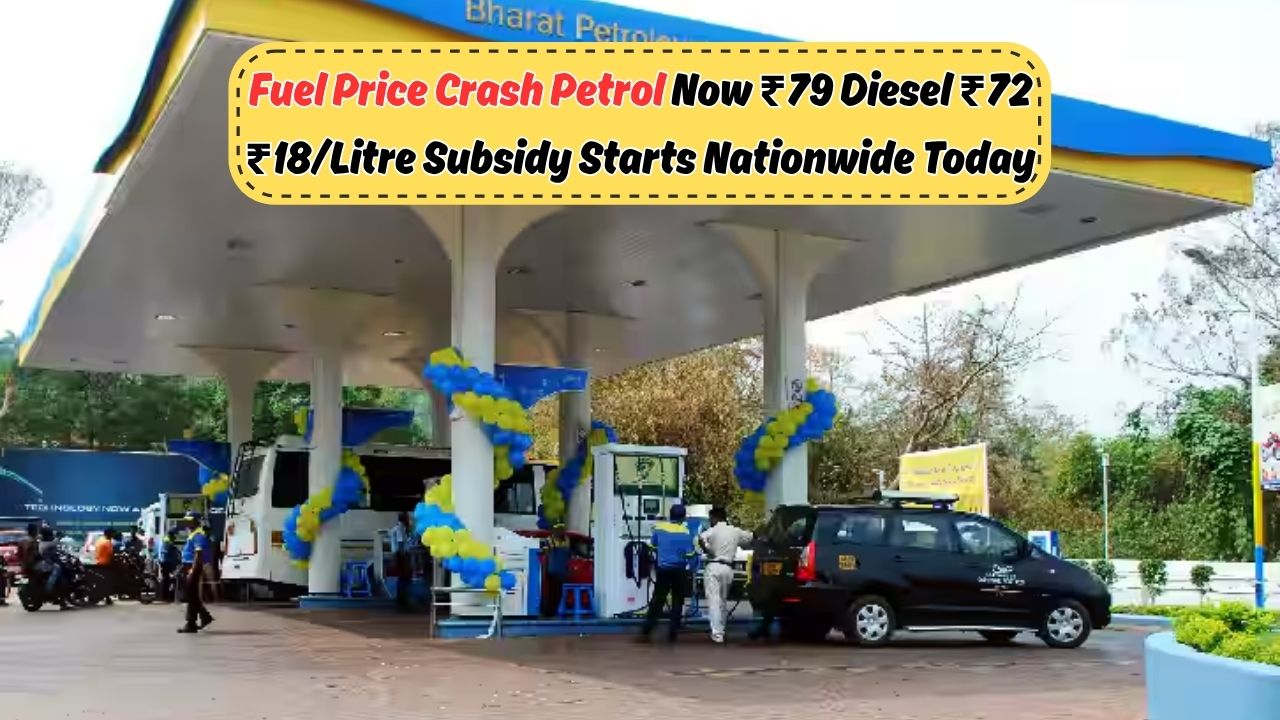Fuel Prices Crashed – In a historic move that has sent waves of relief across the nation, the Indian government has announced a major subsidy of ₹18 per litre on petrol and diesel. From today, fuel prices have dropped drastically, with petrol now available at just ₹79 per litre and diesel at ₹72 per litre in all states. This significant price cut is expected to bring down transportation costs, reduce inflation, and provide financial relief to millions of households and businesses. The announcement comes at a time when rising fuel costs had become a serious burden on the common man, triggering inflation in essential goods and services. With this bold step, the government aims to control prices and boost consumer spending ahead of the festive season.
Why This Fuel Price Cut Matters
This fuel price crash is not just about cheaper petrol and diesel. It’s a game-changing economic intervention with nationwide implications. Here’s why this move is being hailed as a breakthrough:
- ₹18/litre direct subsidy applied on both petrol and diesel
- Prices revised across all states and union territories
- Huge savings for private vehicle owners, truckers, and transporters
- Expected decline in overall inflation levels
- Increased affordability for middle and lower-income households
- Boost to sectors like logistics, agriculture, and tourism
Updated Fuel Prices State-by-State
The subsidy has been applied uniformly, but the actual prices may slightly vary based on state-level VAT. Here’s a look at the latest retail prices post-subsidy:
| State | Old Petrol Price | New Petrol Price | Old Diesel Price | New Diesel Price |
|---|---|---|---|---|
| Delhi | ₹97 | ₹79 | ₹90 | ₹72 |
| Maharashtra | ₹105 | ₹87 | ₹96 | ₹78 |
| Tamil Nadu | ₹102 | ₹84 | ₹95 | ₹77 |
| Uttar Pradesh | ₹98 | ₹80 | ₹91 | ₹73 |
| West Bengal | ₹99 | ₹81 | ₹93 | ₹75 |
| Gujarat | ₹96 | ₹78 | ₹89 | ₹71 |
| Karnataka | ₹101 | ₹83 | ₹94 | ₹76 |
| Rajasthan | ₹106 | ₹88 | ₹97 | ₹79 |
Impact on Daily Expenses and Monthly Budgets
The drop in fuel prices is expected to lower expenses across several sectors. Households, transport companies, and even food delivery businesses will see considerable savings. Here’s a breakdown of potential monthly savings for the average consumer:
| Category | Pre-Cut Expense (Monthly) | Post-Cut Expense | Estimated Savings |
|---|---|---|---|
| Daily Commuters (2-Wheeler) | ₹2,000 | ₹1,600 | ₹400 |
| Taxi Operators | ₹10,000 | ₹8,200 | ₹1,800 |
| Logistics Firms (Per Truck) | ₹45,000 | ₹36,000 | ₹9,000 |
| Food Delivery Riders | ₹4,500 | ₹3,700 | ₹800 |
| Middle-Class Households | ₹5,000 | ₹4,000 | ₹1,000 |
| Farmers (Diesel Pumps Use) | ₹3,000 | ₹2,400 | ₹600 |
| App-Based Cabs (Monthly) | ₹18,000 | ₹14,800 | ₹3,200 |
| School Transport Vans | ₹6,000 | ₹4,800 | ₹1,200 |
How the Subsidy Will Work
The ₹18/litre subsidy is being centrally funded and will be auto-applied at fuel stations:
- No paperwork or registration required
- Prices adjusted automatically at the pump
- Valid across both government and private petrol stations
- Applicable for all categories: individuals, commercial users, and agricultural needs
- No daily purchase limit or restrictions
This seamless implementation ensures that every Indian benefits equally from the price cut without bureaucratic delays.
Economic & Political Implications
This fuel price reduction is being seen as a strategic decision with strong political and economic motives:
- Likely boost in public sentiment ahead of upcoming elections
- Increased mobility expected to improve economic productivity
- May reduce input costs for industries reliant on transport
- Could trigger a temporary rise in domestic tourism due to cheaper travel
- Expected improvement in core inflation data in the coming months
Sector-Wise Reactions to Fuel Subsidy
| Sector | Reaction Summary |
|---|---|
| Transport | Transport unions welcomed the relief |
| Agriculture | Farmers praised diesel subsidy for pump use |
| Retail | Expect lower delivery costs and prices |
| Auto Industry | Surge in vehicle sales expected |
| Aviation | Pressure mounts to extend subsidy to ATF |
| Politics | Opposition demands longer-term roadmap |
| Common Citizens | Hailing the move as long overdue |
The government’s ₹18 per litre fuel subsidy has proven to be a major relief at a time when inflation was biting hard. While the long-term sustainability of such a subsidy remains a question, the immediate economic boost it offers is undeniable. The reduction of petrol to ₹79 and diesel to ₹72 per litre has brought visible relief to millions of citizens across India.
As households, transporters, and businesses begin to experience the positive effects of reduced fuel costs, many are hoping that this move signals the start of more people-friendly reforms in essential sectors.
FAQs
1. How long will this ₹18/litre fuel subsidy last?
The government has not specified an end date. Officials stated the subsidy will remain “until further notice,” with monthly reviews.
2. Do I need to register anywhere to get the discounted fuel prices?
No, the subsidy is automatically applied at all fuel stations nationwide. No registration or application is needed.
3. Are LPG and CNG also included in this subsidy scheme?
No, this current fuel subsidy is only applicable to petrol and diesel. LPG and CNG prices remain unchanged.
4. Will this price drop affect fuel quality or availability?
No changes are expected in fuel quality or supply. Oil marketing companies are fully stocked and operating as usual.
5. Can commercial vehicles and businesses also avail this subsidy?
Yes, there are no category restrictions. Both private and commercial vehicles benefit from the reduced rates.
